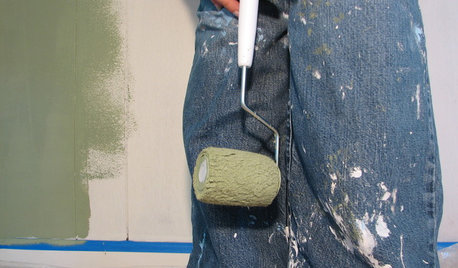I've been in the garden... murdering caterpillars! Someone help!
jannaramsey
18 years ago
Featured Answer
Comments (22)
Okiedawn OK Zone 7
18 years agolast modified: 9 years agosusanlynne48
18 years agolast modified: 9 years agoRelated Discussions
All this time I've been wrong?????
Comments (52)Peat makes an excellent preservative. The modern horticultural practice of using a sterile medium like peat is in order to create a hydroponic environment, that can force-feed plants into rapid production. I've found a few nurseries who grow in-pot organically, and they avoid peat. I don't see large chunks of pine bark in their soil medium, either. Some use rainwater to irrigate, most are wholesale and at least one is open to the public. Transplanting and establishment ease have been outstanding with these trees grown organically with a comost-based medium. Some use pots that are designed to eliminate circling roots. This is a far superior product, that establishes and plants easier, than any tree grown in peat, or in a plastic pot. It's really a leap were speaking of, for a root to make the transition from an extremely acidic, sterile medium to a nearly neutral, live mineal soil. It ain't natural, and creates unnecessary stress on the plant when it needs it least-- during root establishment. But we grow potted plants in peat, anyways. Modern horticularal practices do not serve the grower so well, Most of the potted trees and plants you'll find in a retail nursery, have been force fed to grow lots of pretty foliage, in a poor soil medium, with underdeveloped and potbound roots. I know peat is good at preserving cave people and tubulars. But as a potting medium, it's used becasuse it is thought to be cheap, and that's the bottom line. There are conflicts of interest between the grower and the hulticulturalist who pushes peat as a pot medium. A lot of the carp they teach in hort school (and ag school, and other fields), has a bias towards perceived economic benefits, and can ignore for years, better, sounder science. M This post was edited by Mackel-in-DFW on Fri, Apr 25, 14 at 23:01...See MoreI've been reading a lot of old posts and...
Comments (2)I do the same thing, I love perusing the old posts. Iron sharpens iron, it's fun getting inspiration from other like minded folks. I believe we are in a world all our own lol you should see the looks I get when I start talking plants with someone who isn't a gardener. Sometimes I just can't help it. But it's fun to strike up convo. in the nurseries with other garden nuts. lol I am in zone 8 but 9 AHS. We have high temps. 105-113 for 40+ straight days in the summer with very little rain if any. Tough gardening conditions for sure. Rena'...See MoreHelp prevent Mango Murder! Advice needed for new gardener.
Comments (3)Stephen: Not to worry...a mango seed cannot really be planted the wrong way. The tap root will always head towards the source of gravity and the stem growth will always head towards light. Nothing you do will stop that process. Stand back and let nature take its course. Good luck with your mango seedling. Hrry...See MoreI've have been sent here for ideas
Comments (57)mtn- I grew up in the Saratoga area, spent many evenings at harness racing- fun. BTW harness racing is also something to do in Maine at Scarborough Downs. Since you will be going to Saratoga in August the regular season will also be open. The town I grew up in is Schuylerville. At the time of the revolutionary war, it was actually called Saratoga and it is where the General Burgoyne surrendered to General Gates. I remember vividly cross country practice always included running up the monument steps. To this day I remember there are 184 steps. A couple of regional suggestions, see if you can fit in the Corning Glass Museum. RE the fingerlakes region I recently read What She Left Behind by Ellen Wiseman and got re-fascinated with the histrory of the treatment of the mentally ill. I say re-fascinated because when I was around your daughter's age I read everything I could about Nellie Bly and of course her expose about Blackwell's Island was pivotal in her life. This might make interesting tie-ins. And as you approach home territory, the Storm King Art Center and its fabulous sculpture garden is one of my most favorite places in the world....See MoreChlorophyllJill
18 years agolast modified: 9 years agoChlorophyllJill
18 years agolast modified: 9 years agojannaramsey
18 years agolast modified: 9 years agosusanlynne48
18 years agolast modified: 9 years agoTomato_Worm59
18 years agolast modified: 9 years agoOKC1
18 years agolast modified: 9 years agosusanlynne48
18 years agolast modified: 9 years agodragonladytoo
18 years agolast modified: 9 years agoTomato_Worm59
18 years agolast modified: 9 years agoOKC1
18 years agolast modified: 9 years agosusanlynne48
18 years agolast modified: 9 years agoTomato_Worm59
18 years agolast modified: 9 years agoOKC1
18 years agolast modified: 9 years agoOkiedawn OK Zone 7
18 years agolast modified: 9 years agosusanlynne48
18 years agolast modified: 9 years agoklflorida
18 years agolast modified: 9 years agosusanlynne48
18 years agolast modified: 9 years agovixen77
16 years agolast modified: 9 years agoOkiedawn OK Zone 7
16 years agolast modified: 9 years ago
Related Stories

SMALL HOMES16 Smart Ideas for Small Homes From People Who’ve Been There
Got less than 1,000 square feet to work with? These design-savvy homeowners have ideas for you
Full Story
DECORATING GUIDESThe Dumbest Decorating Decisions I’ve Ever Made
Caution: Do not try these at home
Full Story
PAINTINGHelp! I Spilled Paint on My Clothes — Now What?
If you’ve spattered paint on your favorite jeans, here’s what to do next
Full Story
FLOWERS AND PLANTSHelp Monarchs and Other Butterflies by Planting Common Milkweed
Summer-blooming Asclepias syriaca is an important larval host plant for the monarch butterfly and attracts a number of pollinating insects
Full Story
EXTERIORSHelp! What Color Should I Paint My House Exterior?
Real homeowners get real help in choosing paint palettes. Bonus: 3 tips for everyone on picking exterior colors
Full Story
MOST POPULAR9 Real Ways You Can Help After a House Fire
Suggestions from someone who lost her home to fire — and experienced the staggering generosity of community
Full Story
ORGANIZINGGet the Organizing Help You Need (Finally!)
Imagine having your closet whipped into shape by someone else. That’s the power of working with a pro
Full Story
CONTAINER GARDENSPatio-Perfect Berry Bushes Like You’ve Never Seen
Small enough for pots but offering abundant fruit, these remarkable bred berries are a boon for gardeners short on space
Full Story
GARDENING GUIDES12 Tips to Help You Start an Edible Garden
Get on your way to growing your own vegetables with a raised bed or a few containers on the patio
Full StorySponsored




Okiedawn OK Zone 7